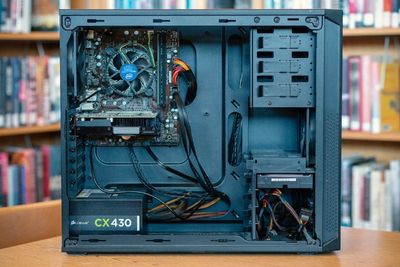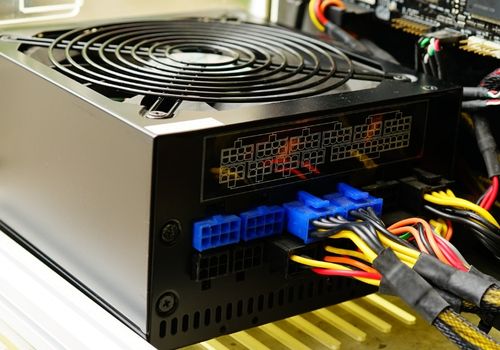
If you’re using a pre-built computer, search up your PC model along with “power supply” next to it. Reviews and even info pages from your computer manufacturer’s site should pop up and tell you what your power supply unit (PSU) is.
It gets a bit easier if you have a custom-built PC. You probably have the warranty your PSU came with. It should have information on your PSU model somewhere written on.
When you’ve dealt with as many motherboards and graphics cards as I have, you’ll know what your PSU is at all times. However, when I first started out, I had to manually keep checking what my power supply was. I used to look at its warranty to figure this out.
If you’d like to learn more about this, read ahead.
Contents
There are a few ways to find out what your computer’s power supply model is. I’ve categorized them depending on whether your PC is pre-built or custom made.

Type in your computer’s model along with a keyword relating to power supplies, like ‘PSU’. You should see a bunch of information on your power source from either your official computer manufacturer’s site, review pages, or forum threads.
If you don’t know your PC’s model, you can find out by checking the manual. You should be able to find information about your PSU in it.
What should you do if you don’t have your manual, and have no idea what your PC model is? Head to your PC’s settings to find your computer model (then Google the power supply’s model). Here’s what you do:
If you have a custom built computer, you probably installed your power supply yourself. Check its warranty or the box it came in. You should find information about its model.
You can also open up your computer and find the PSU yourself. This is usually easy to do on custom PCs, as you have probably installed a case that’s easy to detach.
Follow these steps to check your PC’s power supply:
Once you know what PSU you have, you can figure out how much power it can output by doing a quick Google search. If you’re facing PC problems, this can help narrow down whether it’s because your PSU can’t supply enough power.
Of course, you’ll need the help of third-party tools to figure this out, like the Newegg power supply calculator. After you’ve included all the relevant information onto the tool, you will know the appropriate power delivery needed to run your hardware.
If you know what your power supply’s maximum level is, this can help you decide whether you should look for other PSU manufacturers.
The biggest sign to keep an eye out for is whether your computer shuts down during graphic-extensive processes. This usually happens when your PSU can’t send in a lot of power, so it gives out.
As mentioned above, it’s important to know what your PSU is. If you’re thinking of getting a new one, keep these factors in mind:
Your PSU’s wattage is the maximum power that it can supply to your system’s components.
If your power supply’s wattage is high, you’ll be able to handle powerful PC parts. They draw in the most amount of power.
Dimensions are important when it comes to buying power supplies if you have a pre-built computer. You’ll need a unit that fits exactly into your PC case, along with all the other parts. I recommend taking your old PSU to the store to find one that’s around the same size.
If you’re building a PC from scratch, you don’t have to be particular about size and form factor. You can maybe build around your power supply if you find a good one.
You can divide PSUs into 2 main standards - ATX and SFX. Generally speaking, SFX power supplies are smaller in size, with dimensions of around 125 mm x 100 mm x 63.5 mm.
When it comes to ATX options, their dimensions are around 150 mm x 86 mm x 140 mm. Apart from size, there are a few more differences which you can learn about in this guide.
You can find power supplies in either modular, semi-modular, or non-modular options. If you go the traditional, non-modular route, your PSU’s cables will be permanently attached to it. As you might have guessed, this isn’t the case with fully modular options.
The biggest advantage of going the modular route is that you get full control of your PSU connections. You’ll be able to improve airflow, and aesthetics (which is important in gaming PCs).
Just know that if you go the modular route, you will have to use the proprietary cables provided by the manufacturer. If you find other aftermarket cables from the same manufacturer, they might not be compatible.

Efficiency refers to how well your PSU uses power without expending it on PC components as heat. To get an efficient PSU, you’ll have to look for the 80 Plus rating. All electronics have to be at least 80 percent efficient with their energy.
A good PSU will have fail-safes to keep your system safe in case of power surges, to prevent it from heating up or burning.
There are quite a few ways to find out what power supply you have, depending on whether you have a custom or pre-built PC. If you have a pre-built computer, google your PC model, to find more about its power unit online.
However, if you have a custom-build, things get easier. If you have your PSU’s warranty, your PSU model will be mentioned on it.
You can remove your computer case and manually check your PSU too. This is easy to do on custom builds. You should be able to find your PSU in a closed container near your PC’s power wire port.
Apart from how to check power supply units, I also looked at other factors you can find on your PSU label, such as how much power it can generate, and its input voltage and output voltage.
